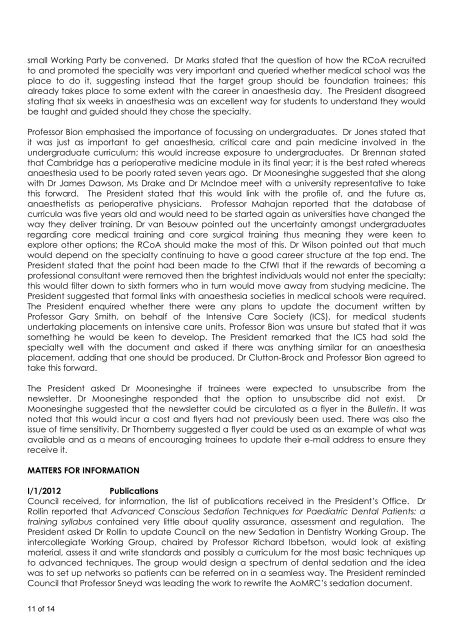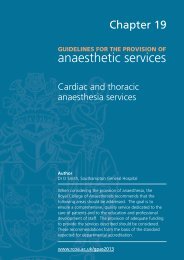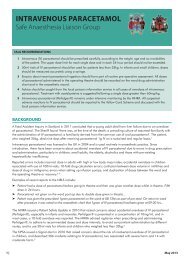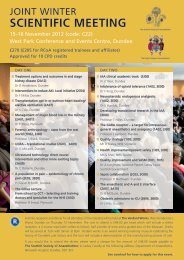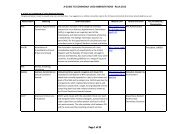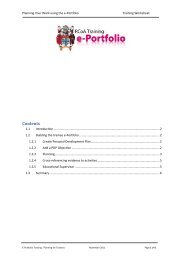January - The Royal College of Anaesthetists
January - The Royal College of Anaesthetists
January - The Royal College of Anaesthetists
You also want an ePaper? Increase the reach of your titles
YUMPU automatically turns print PDFs into web optimized ePapers that Google loves.
small Working Party be convened. Dr Marks stated that the question <strong>of</strong> how the RCoA recruited<br />
to and promoted the specialty was very important and queried whether medical school was the<br />
place to do it, suggesting instead that the target group should be foundation trainees; this<br />
already takes place to some extent with the career in anaesthesia day. <strong>The</strong> President disagreed<br />
stating that six weeks in anaesthesia was an excellent way for students to understand they would<br />
be taught and guided should they chose the specialty.<br />
Pr<strong>of</strong>essor Bion emphasised the importance <strong>of</strong> focussing on undergraduates. Dr Jones stated that<br />
it was just as important to get anaesthesia, critical care and pain medicine involved in the<br />
undergraduate curriculum; this would increase exposure to undergraduates. Dr Brennan stated<br />
that Cambridge has a perioperative medicine module in its final year; it is the best rated whereas<br />
anaesthesia used to be poorly rated seven years ago. Dr Moonesinghe suggested that she along<br />
with Dr James Dawson, Ms Drake and Dr McIndoe meet with a university representative to take<br />
this forward. <strong>The</strong> President stated that this would link with the pr<strong>of</strong>ile <strong>of</strong>, and the future as,<br />
anaesthetists as perioperative physicians. Pr<strong>of</strong>essor Mahajan reported that the database <strong>of</strong><br />
curricula was five years old and would need to be started again as universities have changed the<br />
way they deliver training. Dr van Besouw pointed out the uncertainty amongst undergraduates<br />
regarding core medical training and core surgical training thus meaning they were keen to<br />
explore other options; the RCoA should make the most <strong>of</strong> this. Dr Wilson pointed out that much<br />
would depend on the specialty continuing to have a good career structure at the top end. <strong>The</strong><br />
President stated that the point had been made to the CfWI that if the rewards <strong>of</strong> becoming a<br />
pr<strong>of</strong>essional consultant were removed then the brightest individuals would not enter the specialty;<br />
this would filter down to sixth formers who in turn would move away from studying medicine. <strong>The</strong><br />
President suggested that formal links with anaesthesia societies in medical schools were required.<br />
<strong>The</strong> President enquired whether there were any plans to update the document written by<br />
Pr<strong>of</strong>essor Gary Smith, on behalf <strong>of</strong> the Intensive Care Society (ICS), for medical students<br />
undertaking placements on intensive care units. Pr<strong>of</strong>essor Bion was unsure but stated that it was<br />
something he would be keen to develop. <strong>The</strong> President remarked that the ICS had sold the<br />
specialty well with the document and asked if there was anything similar for an anaesthesia<br />
placement, adding that one should be produced. Dr Clutton-Brock and Pr<strong>of</strong>essor Bion agreed to<br />
take this forward.<br />
<strong>The</strong> President asked Dr Moonesinghe if trainees were expected to unsubscribe from the<br />
newsletter. Dr Moonesinghe responded that the option to unsubscribe did not exist. Dr<br />
Moonesinghe suggested that the newsletter could be circulated as a flyer in the Bulletin. It was<br />
noted that this would incur a cost and flyers had not previously been used. <strong>The</strong>re was also the<br />
issue <strong>of</strong> time sensitivity. Dr Thornberry suggested a flyer could be used as an example <strong>of</strong> what was<br />
available and as a means <strong>of</strong> encouraging trainees to update their e-mail address to ensure they<br />
receive it.<br />
MATTERS FOR INFORMATION<br />
I/1/2012 Publications<br />
Council received, for information, the list <strong>of</strong> publications received in the President’s Office. Dr<br />
Rollin reported that Advanced Conscious Sedation Techniques for Paediatric Dental Patients: a<br />
training syllabus contained very little about quality assurance, assessment and regulation. <strong>The</strong><br />
President asked Dr Rollin to update Council on the new Sedation in Dentistry Working Group. <strong>The</strong><br />
intercollegiate Working Group, chaired by Pr<strong>of</strong>essor Richard Ibbetson, would look at existing<br />
material, assess it and write standards and possibly a curriculum for the most basic techniques up<br />
to advanced techniques. <strong>The</strong> group would design a spectrum <strong>of</strong> dental sedation and the idea<br />
was to set up networks so patients can be referred on in a seamless way. <strong>The</strong> President reminded<br />
Council that Pr<strong>of</strong>essor Sneyd was leading the work to rewrite the AoMRC’s sedation document.<br />
11 <strong>of</strong> 14


